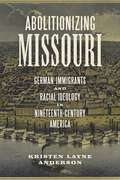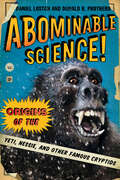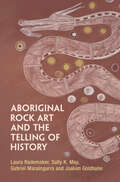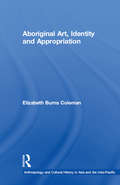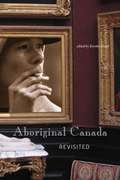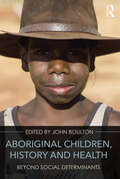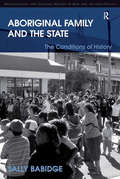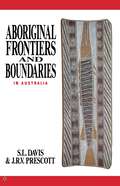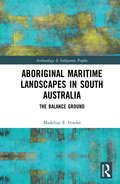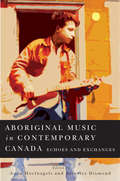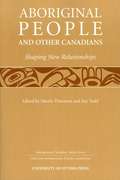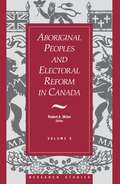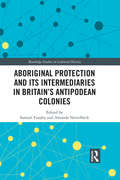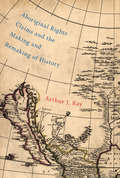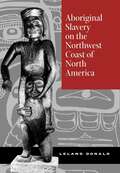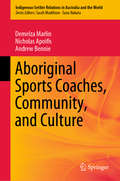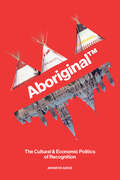- Table View
- List View
Abolitionists Remember
by Julie Roy JeffreyIn Abolitionists Remember, Julie Roy Jeffrey illuminates a second, little-noted antislavery struggle as abolitionists in the postwar period attempted to counter the nation's growing inclination to forget why the war was fought, what slavery was really like, and why the abolitionist cause was so important. In the rush to mend fences after the Civil War, the memory of the past faded and turned romantic--slaves became quaint, owners kindly, and the war itself a noble struggle for the Union. Jeffrey examines the autobiographical writings of former abolitionists such as Laura Haviland, Frederick Douglass, Parker Pillsbury, and Samuel J. May, revealing that they wrote not only to counter the popular image of themselves as fanatics, but also to remind readers of the harsh reality of slavery and to advocate equal rights for African Americans in an era of growing racism, Jim Crow, and the Ku Klux Klan. These abolitionists, who went to great lengths to get their accounts published, challenged every important point of the reconciliation narrative, trying to salvage the nobility of their work for emancipation and African Americans and defending their own participation in the great events of their day.
Abolitionizing Missouri: German Immigrants and Racial Ideology in Nineteenth-Century America (Antislavery, Abolition, and the Atlantic World)
by Kristen Layne AndersonHistorians have long known that German immigrants provided much of the support for emancipation in southern Border States. Kristen Layne Anderson's Abolitionizing Missouri, however, is the first analysis of the reasons behind that opposition as well as the first exploration of the impact that the Civil War and emancipation had on German immigrants' ideas about race. Anderson focuses on the relationships between German immigrants and African Americans in St. Louis, Missouri, looking particularly at the ways in which German attitudes towards African Americans and the institution of slavery changed over time. Anderson suggests that although some German Americans deserved their reputation for racial egalitarianism, many others opposed slavery only when it served their own interests to do so. When slavery did not seem to affect their lives, they ignored it; once it began to threaten the stability of the country or their ability to get land, they opposed it. After slavery ended, most German immigrants accepted the American racial hierarchy enough to enjoy its benefits, and had little interest in helping tear it down, particularly when doing so angered their native-born white neighbors. Anderson's work counters prevailing interpretations in immigration and ethnic history, where until recently, scholars largely accepted that German immigrants were solidly antislavery. Instead, she uncovers a spectrum of Germans' "antislavery" positions and explores the array of individual motives driving such diverse responses. . In the end, Anderson demonstrates that Missouri Germans were more willing to undermine the racial hierarchy by questioning slavery than were most white Missourians, although after emancipation, many of them showed little interest in continuing to demolish the hierarchy that benefited them by fighting for black rights.
Abominable Science!: Origins of the Yeti, Nessie, and Other Famous Cryptids
by Donald R. Prothero Daniel LoxtonThroughout our history, humans have been captivated by mythic beasts and legendary creatures. Tales of Bigfoot, the Yeti, and the Loch Ness monster are part of our collective experience. Now comes a book from two dedicated investigators that explores and elucidates the fascinating world of cryptozoology. Daniel Loxton and Donald R. Prothero have written an entertaining, educational, and definitive text on cryptids, presenting the arguments both for and against their existence and systematically challenging the pseudoscience that perpetuates their myths. After examining the nature of science and pseudoscience and their relation to cryptozoology, Loxton and Prothero take on Bigfoot; the Yeti, or Abominable Snowman, and its cross-cultural incarnations; the Loch Ness monster and its highly publicized sightings; the evolution of the Great Sea Serpent; and Mokele Mbembe, or the Congo dinosaur. They conclude with an analysis of the psychology behind the persistent belief in paranormal phenomena, identifying the major players in cryptozoology, discussing the character of its subculture, and considering the challenge it poses to clear and critical thinking in our increasingly complex world.
Abominable Science!: Origins of the Yeti, Nessie, and Other Famous Cryptids
by Donald R. Prothero Daniel Loxton&“A sharp analysis of the quest for unreal critters―cryptids, as they are called―and the people who pursue them . . . entertaining and thoroughly documented.&” —The Wall Street Journal Throughout our history, humans have been captivated by mythic beasts and legendary creatures. Tales of Bigfoot, the Yeti, and the Loch Ness monster are part of our collective experience. Now comes a book from two dedicated investigators that explores and elucidates the fascinating world of cryptozoology. Daniel Loxton and Donald R. Prothero have written an entertaining, educational, and definitive text on cryptids, presenting the arguments both for and against their existence and systematically challenging the pseudoscience that perpetuates their myths. After examining the nature of science and pseudoscience and their relation to cryptozoology, Loxton and Prothero take on Bigfoot; the Yeti, or Abominable Snowman, and its cross-cultural incarnations; the Loch Ness monster and its highly publicized sightings; the evolution of the Great Sea Serpent; and Mokele Mbembe, or the Congo dinosaur. They conclude with an analysis of the psychology behind the persistent belief in paranormal phenomena, identifying the major players in cryptozoology, discussing the character of its subculture, and considering the challenge it poses to clear and critical thinking in our increasingly complex world. &“As valuable for its analysis of the hunted as it is for the light it shines on the still-hopeful hunters.&” —Publishers Weekly &“Highly recommended for readers looking for scientific but accessible evaluations of the existence of five notable cryptids that have captured our imaginations.&” —Library Journal (starred review)
Aboriginal Art and Australian Racial Hegemony: Decolonising Consciousness
by Abraham BradfieldThis book explores the complexities of Indigenous and non-Indigenous relations in contemporary Australia. It unpacks the continuation of a pervasive colonial consciousness within settler-colonial settings, but also provokes readers to confront their own habits of thought and action. Through presenting a reflexive narrative that draws on the author’s encounters with Indigenous artists and their artwork, knowledge, stories, and lived experiences, this provocative and insightful work encourages readers to consider what decolonising means to them. It presents a compelling and relevant argument that calls for a reorientation of dominant discourses fixed within Eurocentric frameworks, whilst also addressing the deep complexities and challenges of living within intercultural settler-colonial settings where different views and perspectives clash and complement one another.
Aboriginal Art and the Telling of History
by Laura Rademaker Sally K. May Gabriel Maralngurra Joakim GoldhahnThe rock art of Australia is among the oldest, most complex, and most fascinating manifestations of human creativity and imagination in the world. Aboriginal people used art to record their experiences, ceremonies, and knowledge by embedding their understanding of the world in the landscape over many generations. Indeed, rock art serves as archives and libraries for Australia's Indigenous people. It is, in effect, its repository of memory. This volume explores Indigenous perspectives on rock art. It challenges the limits and assumptions of traditional, academic ways of understanding and knowing the past by showing how history has literally been painted 'on the rocks'. Each chapter features a biography of an artist or family of artists, together with an artwork created by contemporary artist Gabriel Maralngurra. By bringing together history, archaeology, and Indigenous artistic practice, the book offers new insights into the medium of rock art and demonstrates the limits of academic methods and approaches.
Aboriginal Art, Identity and Appropriation (Anthropology and Cultural History in Asia and the Indo-Pacific)
by Elizabeth Burns ColemanThe belief held by Aboriginal people that their art is ultimately related to their identity, and to the continued existence of their culture, has made the protection of indigenous peoples' art a pressing matter in many postcolonial countries. The issue has prompted calls for stronger copyright legislation to protect Aboriginal art. Although this claim is not particular to Australian Aboriginal people, the Australian experience clearly illustrates this debate. In this work, Elizabeth Burns Coleman analyses art from an Australian Aboriginal community to interpret Aboriginal claims about the relationship between their art, identity and culture, and how the art should be protected in law. Through her study of Yolngu art, Coleman finds Aboriginal claims to be substantially true. This is an issue equally relevant to North American debates about the appropriation of indigenous art, and the book additionally engages with this literature.
Aboriginal Canada Revisited: Politics And Cultural Expression In The 21st Century (International Canadian Studies Series)
by Kerstin KnopfExploring a variety of topics—including health, politics, education, art, literature, media, and film—Aboriginal Canada Revisited draws a portrait of the current political and cultural position of Canada’s Aboriginal peoples. While lauding improvements made in the past decades, the contributors draw attention to the systemic problems that continue to marginalize Aboriginal people within Canadian society.From the Introduction: “[This collection helps] to highlight areas where the colonial legacy still takes its toll, to acknowledge the manifold ways of Aboriginal cultural expression, and to demonstrate where Aboriginal and non-Aboriginal people are starting to find common ground.”Contributors include Aboriginal and non-Aboriginal scholars from Europe and Canada, including Marlene Atleo, University of Manitoba; Mansell Griffin, Nisga’a Village of Gitwinksihlkw, British Columbia; Robert Harding, University College of the Fraser Valley; Tricia Logan, University of Manitoba; Steffi Retzlaff, McMaster University; Siobhán Smith, University of British Columbia; Barbara Walberg, Confederation College.
Aboriginal Children, History and Health: Beyond Social Determinants
by John BoultonThis volume traces the complex reasons behind the disturbing discrepancy between the health and well-being of children in mainstream Australia and those in remote Indigenous communities. Invaluably informed by Boulton’s close working knowledge of Aboriginal communities, the book addresses growth faltering as a crisis of Aboriginal parenting and a continued problem for the Australian nation. The high rate and root causes of ill-health amongst Aboriginal children are explored through a unique synthesis of historical, anthropological, biological and medical analyses. Through this fresh approach, which includes the insights of specialists from a range of disciplines, Aboriginal Children, History and Health provides a thoughtful and innovative framework for considering Indigenous health.
Aboriginal Family and the State: The Conditions of History (Anthropology and Cultural History in Asia and the Indo-Pacific)
by Sally BabidgeAboriginal Family and the State examines the contemporary relations and history of Indigenous families in Australia, specifically referencing issues of government control and recent official recognition of Aboriginal 'traditional owners'. Drawing on detailed empirical research, it develops a discussion of the anthropological issues of kinship and relatedness within colonial and 'postcolonial' contexts. This volume explores the conditions affecting the formation of 'family' among indigenous people in rural northern Australia, as well as the contingencies of 'family' in the legal and political context of contemporary indigenous claims to land. With a rich discussion of the production, practice and inscription of social relations, this volume examines everyday expressions of 'family', and events such as meetings and funerals, demonstrating that kinship is formed and reformed through a complicated social practice of competing demands on identity.
Aboriginal Frontiers And Boundaries In Australia
by J. R. Prescott S. L. DavisBefore the coming of Europeans, Aboriginal communities lived within territories defined by complex ritual cycles of song, dance, symbol and ceremony. Knowledge of these boundaries and frontiers was in the keeping of senior custodians. In traditional communities, this continues to be the situation. Today, white Australians belatedly acknowledge Aboriginal land rights and the special significance of sacred sites. This makes an understanding of the boundaries vital to the achievement of basic land and sea rights for Aboriginal people. Unfortunately, over much of the continent, knowledge of boundaries has been lost or is in danger of being lost. In this work two political geographers explore the nature of Aboriginal boundaries and their contemporary implications. In four detailed case studies they challenge many of the assumptions which have underpinned the involvement of white advisers. The result is a timely study which raises important questions about an issue of national significance.
Aboriginal Health in Canada
by D. Ann Herring James Waldram T. Kue YoungNumerous studies, inquiries, and statistics accumulated over the years have demonstrated the poor health status of Aboriginal peoples relative to the Canadian population in general. Aboriginal Health in Canada is about the complex web of physiological, psychological, spiritual, historical, sociological, cultural, economic, and environmental factors that contribute to health and disease patterns among the Aboriginal peoples of Canada. The authors explore the evidence for changes in patterns of health and disease prior to and since European contact, up to the present. They discuss medical systems and the place of medicine within various Aboriginal cultures and trace the relationship between politics and the organization of health services for Aboriginal people. They also examine popular explanations for Aboriginal health patterns today, and emphasize the need to understand both the historical-cultural context of health issues, as well as the circumstances that give rise to variation in health problems and healing strategies in Aboriginal communities across the country. An overview of Aboriginal peoples in Canada provides a very general background for the non-specialist. Finally, contemporary Aboriginal healing traditions, the issue of self-determination and health care, and current trends in Aboriginal health issues are examined.
Aboriginal Maritime Landscapes in South Australia: The Balance Ground (Archaeology & Indigenous Peoples)
by Madeline E. FowlerAboriginal Maritime Landscapes in South Australia reveals the maritime landscape of a coastal Aboriginal mission, Burgiyana (Point Pearce), in South Australia, based on the experiences of the Narungga community. A collaborative initiative with Narungga peoples and a cross-disciplinary approach have resulted in new understandings of the maritime history of Australia. Analysis of the long-term participation of Narungga peoples in Australia’s maritime past, informed by Narungga oral histories, primary archival research and archaeological fieldwork, delivers insights into the world of Aboriginal peoples in the post-contact maritime landscape. This demonstrates that multiple interpretations of Australia’s maritime past exist and provokes a reconsideration of how the relationship between maritime and Indigenous archaeology is seen. This book describes the balance ground shaped through the collaboration, collision and reconciliation of Aboriginal and non-Aboriginal peoples in Australia. It considers community-based practices, cohesively recording such areas of importance to Aboriginal communities as beliefs, knowledges and lived experiences through a maritime lens, highlighting the presence of Narungga and Burgiyana peoples in a heretofore Western-dominated maritime literature. Through its consideration of such themes as maritime archaeology and Aboriginal history, the book is of value to scholars in a broad range of disciplines, including archaeology, anthropology, history and Indigenous studies.
Aboriginal Music in Contemporary Canada: Echoes and Exchanges
by Anna Hoefnagels Beverley DiamondFirst Nations, Inuit, and Métis music in Canada is dynamic and diverse, reflecting continuities with earlier traditions and innovative approaches to creating new musical sounds. Aboriginal Music in Contemporary Canada narrates a story of resistance and renewal, struggle and success, as indigenous musicians in Canada negotiate who they are and who they want to be. Comprised of essays, interviews, and personal reflections by Aboriginal and non-Aboriginal musicians and scholars alike, the collection highlights themes of innovation, teaching and transmission, and cultural interaction. Individual chapters discuss musical genres ranging from popular styles including country and pop to nation-specific and intertribal practices such as powwows, as well as hybrid performances that incorporate music with theatre and dance. As a whole, this collection demonstrates how music is a powerful tool for articulating the social challenges faced by Aboriginal communities and an effective way to affirm indigenous strength and pride. Juxtaposing scholarly study with artistic practice, Aboriginal Music in Contemporary Canada celebrates and critically engages Canada's vibrant Aboriginal music scene. Contributors include Véronique Audet (Université de Montreal), Columpa C. Bobb (Tsleil Waututh and Nlaka'pamux, Manitoba Theatre for Young People), Sadie Buck (Haudenosaunee), Annette Chrétien (Métis), Marie Clements (Métis/Dene), Walter Denny Jr. (Mi'kmaw), Gabriel Desrosiers (Ojibwa, University of Minnesota, Morris), Beverley Diamond (Memorial University), Jimmy Dick (Cree), Byron Dueck (Royal Northern College of Music), Klisala Harrison (University of Helsinki), Donna Lariviere (Algonquin), Charity Marsh (University of Regina), Sophie Merasty (Dene and Cree), Garry Oker (Dane-zaa), Marcia Ostashewski (Cape Breton University), Mary Piercey (Memorial University), Amber Ridington (Memorial University), Dylan Robinson (Stó:lo, University of Toronto), Christopher Scales (Michigan State University), Gilles Sioui (Wendat), Gordon E. Smith (Queen's University), Beverly Souliere (Algonquin), Janice Esther Tulk (Memorial University), Florent Vollant (Innu) and Russell Wallace (Lil'wat).
Aboriginal Music in Contemporary: Echoes and Exchanges (McGill-Queen's Indigenous and Northern Studies)
by Anna Hoefnagels Beverley DiamondFirst Nations, Inuit, and Métis music in Canada is dynamic and diverse, reflecting continuities with earlier traditions and innovative approaches to creating new musical sounds. Aboriginal Music in Contemporary Canada narrates a story of resistance and renewal, struggle and success, as indigenous musicians in Canada negotiate who they are and who they want to be. Comprised of essays, interviews, and personal reflections by Aboriginal and non-Aboriginal musicians and scholars alike, the collection highlights themes of innovation, teaching and transmission, and cultural interaction. Individual chapters discuss musical genres ranging from popular styles including country and pop to nation-specific and intertribal practices such as powwows, as well as hybrid performances that incorporate music with theatre and dance. As a whole, this collection demonstrates how music is a powerful tool for articulating the social challenges faced by Aboriginal communities and an effective way to affirm indigenous strength and pride. Juxtaposing scholarly study with artistic practice, Aboriginal Music in Contemporary Canada celebrates and critically engages Canada's vibrant Aboriginal music scene. Contributors include Véronique Audet (Université de Montreal), Columpa C. Bobb (Tsleil Waututh and Nlaka'pamux, Manitoba Theatre for Young People), Sadie Buck (Haudenosaunee), Annette Chrétien (Métis), Marie Clements (Métis/Dene), Walter Denny Jr. (Mi'kmaw), Gabriel Desrosiers (Ojibwa, University of Minnesota, Morris), Beverley Diamond (Memorial University), Jimmy Dick (Cree), Byron Dueck (Royal Northern College of Music), Klisala Harrison (University of Helsinki), Donna Lariviere (Algonquin), Charity Marsh (University of Regina), Sophie Merasty (Dene and Cree), Garry Oker (Dane-zaa), Marcia Ostashewski (Cape Breton University), Mary Piercey (Memorial University), Amber Ridington (Memorial University), Dylan Robinson (Stó:lo, University of Toronto), Christopher Scales (Michigan State University), Gilles Sioui (Wendat), Gordon E. Smith (Queen's University), Beverly Souliere (Algonquin), Janice Esther Tulk (Memorial University), Florent Vollant (Innu) and Russell Wallace (Lil'wat).
Aboriginal People and Colonizers of Western Canada to 1900
by Sarah Alexander CarterThe history of Canada's Aboriginal peoples after European contact is a hotly debated area of study. In Aboriginal People and Colonizers of Western Canada to 1900, Sarah Carter looks at the cultural, political, and economic issues of this contested history, focusing on the western interior, or what would later become Canada's prairie provinces.This wide-ranging survey draws on the wealth of interdisciplinary scholarship of the last three decades. Topics include the impact of European diseases, changing interpretations of fur trade interaction, the Red River settlement as a cultural crossroad, missionaries, treaties, the disappearance of the buffalo, the myths about the Mounties, Canadian 'Indian' policy, and the policies of Aboriginal peoples towards Canada.Carter focuses on the multiplicity of perspectives that exist on past events. Referring to nearly all of the current scholarship in the field, she presents opposing versions on every major topic, often linking these debates to contemporary issues. The result is a sensitive treatment of history as an interpretive exercise, making this an invaluable text for students as well as all those interested in Aboriginal/Non-Aboriginal relations.
Aboriginal People and Other Canadians: Shaping New Relationships
by Martin Thornton Roy ToddThis book discusses a wide variety of issues in Native studies including social exclusion, marginalization and identity; justice, equality and gender; self-help and empowerment in Aboriginal communities and in the cities; and, methodological and historiographical representations of social relationships.
Aboriginal Peoples and Electoral Reform in Canada: Volume 9
by Robert A. MilenThis volume features differing views of past, present, and possible future roles for Aboriginal people in the Canadian political and electoral system. The studies address the issues facing Aboriginal people and the efforts to increase their involvement in the federal electoral system. Robert Milen examines the development of Aboriginal political consciousness since the 1970s, with attention to recent constitutional and electoral initiatives and aspirations. Augie Fleras’ study considers the New Zealand system of guaranteed representation for the Maori and suggests how Canada might follow this example. Valerie Alia studies how the media deal with Aboriginal issues, basing her recommendations on interviews with Aboriginal people who offered her their views. Roger Gibbins critiques the idea of guaranteed Aboriginal representation in the House of Commons.
Aboriginal Peoples of Canada
by Paul Robert MagocsiCanada's Aboriginal Peoples: A Short Introduction fills a previously overlooked gap by providing the first comprehensive overview of Canada's First Nations people. Drawn from the highly successful Encyclopedia of Canada's Peoples it offers extensive coverage of Canada's aboriginal peoples, including the Algonquians/Eastern Woodlands, Algonquians/Plains, Algonquians/Subarctic, Inuit, Iroquoians, Ktunaxa, Metis, Na-Dene, Salish, Siouan, Tsimshian, and Wakashans, as well as the many nations within these larger groupings.With a new preface by Paul Robert Magocsi and an introduction by well-known historian Jim Miller, the collection has papers on each main group written by such scholars as Janet Chute, Olive Dickason, Louis-Jacques Dorais, and Eldon Yellowhorn. Each essay covers economics, culture, language, education, politics, kinship, religion, social organization, identification, and history of each nation, among other topics, and ends with suggestions for further readings. Readable and suitable for the student, casual reader or expert, the book is an excellent introduction to Canada's aboriginal peoples.
Aboriginal Protection and Its Intermediaries in Britain’s Antipodean Colonies (Routledge Studies in Cultural History #74)
by Amanda Nettelbeck Samuel FurphyThis collection brings together world-leading and emerging scholars to explore how the concept of "protection" was applied to Indigenous peoples of Britain’s antipodean colonies. Tracing evolutions in protection from the 1830s until the end of the nineteenth century, the contributors map the changes and continuities that marked it as an inherently ambivalent mode of colonial practice. In doing so, they consider the place of different historical actors who were involved in the implementation of protective policy, who served as its intermediaries on the ground, or who responded as its intended "beneficiaries." These included metropolitan and colonial administrators, Protectors or similar agents, government interpreters and church-affiliated missionaries, settlers with economic investments in the politics of conciliation, and the Indigenous peoples who were themselves subjected to colonial policies. Drawing out some of the interventions and encounters lived out in the name of protection, the book examines some of the critical roles it played in the making of colonial relations.
Aboriginal Rights Claims and the Making and Remaking of History
by Arthur J. RayForums such as commissions, courtroom trials, and tribunals that have been established through the second half of the twentieth century to address Aboriginal land claims have consequently created a particular way of presenting Aboriginal, colonial, and national histories. The history that emerges from these land-claims processes is often criticized for being "presentist" - inaccurately interpreting historical actions and actors through the lens of present-day values, practices, and concerns. In Aboriginal Rights Claims and the Making and Remaking of History, Arthur Ray examines how claims-oriented research is often fitted to the existing frames of Indigenous rights law and claims legislation and, as a result, has influenced the development of these laws and legislation. Through a comparative study encompassing Australia, Canada, New Zealand, South Africa, and the United States, Ray also explores the ways in which various procedures and settings for claims adjudication have influenced and changed the use of historical evidence, made space for Indigenous voices, stimulated scholarly debates about the cultural and historical experiences of Indigenous peoples at the time of initial European contact and afterward, and have provoked reactions from politicians and scholars. While giving serious consideration to the flaws and strengths of presentist histories, Aboriginal Rights Claims and the Making and Remaking of History provides Aboriginal, academic, and legal communities with essential information on how history is used and how methods are adapted and changed.
Aboriginal Rights Claims and the Making and Remaking of History (McGill-Queen's Indigenous and Northern Studies #87)
by Arthur J. RayForums such as commissions, courtroom trials, and tribunals that have been established through the second half of the twentieth century to address aboriginal land claims have consequently created a particular way of presenting aboriginal, colonial, and national histories. The history that emerges from these land-claims processes is often criticized for being “presentist” – inaccurately interpreting historical actions and actors through the lens of present-day values, practices, and concerns. In Aboriginal Rights Claims and the Making and Remaking of History, Arthur Ray examines how claims-oriented research is often fitted to the existing frames of indigenous rights law and claims legislation and, as a result, has influenced the development of these laws and legislation. Through a comparative study encompassing the United States, Canada, South Africa, Australia and New Zealand, Ray also explores the ways in which various procedures and settings for claims adjudication have influenced and changed the use of historical evidence, made space for indigenous voices, stimulated scholarly debates about the cultural and historical experiences of indigenous peoples at the time of initial European contact and afterward, and have provoked reactions from politicians and scholars. While giving serious consideration to the flaws and strengths of presentist histories, Aboriginal Rights Claims and the Making and Remaking of History provides communities with essential information on how history is used and how methods are adapted and changed.
Aboriginal Slavery on the Northwest Coast of North America
by Leland DonaldWith his investigation of slavery on the Northwest Coast of North America, Leland Donald makes a significant contribution to our understanding of the aboriginal cultures of this area. He shows that Northwest Coast servitude, relatively neglected by researchers in the past, fits an appropriate cross-cultural definition of slavery. Arguing that slaves and slavery were central to these hunting-fishing-gathering societies, he points out how important slaves were to the Northwest Coast economies for their labor and for their value as major items of exchange. Slavery also played a major role in more famous and frequently analyzed Northwest Coast cultural forms such as the potlatch and the spectacular art style and ritual systems of elite groups.The book includes detailed chapters on who owned slaves and the relations between masters and slaves; how slaves were procured; transactions in slaves; the nature, use, and value of slave labor; and the role of slaves in rituals. In addition to analyzing all the available data, ethnographic and historic, on slavery in traditional Northwest Coast cultures, Donald compares the status of Northwest Coast slaves with that of war captives in other parts of traditional Native North America.
Aboriginal Sports Coaches, Community, and Culture (Indigenous-Settler Relations in Australia and the World #2)
by Nicholas Apoifis Demelza Marlin Andrew BennieThis book is the first to celebrate the stories of this group of Aboriginal mentors and leaders and present them in a form that is accessible to both academic and general audiences. In this book, Aboriginal sport coaches from all over Australia share stories about their involvement in sport and community, offering insight into the diverse experiences of Aboriginal people in settler colonial Australia. This collection amplifies the public voice of Aboriginal coaches who are transforming the social, cultural, and political lives of Aboriginal and non-Aboriginal people. These stories have been overlooked in public discussion about sport and indigeneity. Frank and often funny, these intimate narratives provide insight into the unique experiences and attitudes of this group of coaches. This book deepens our understanding of the shared and contested history of Aboriginal peoples’ engagement with sport in Australia.
Aboriginal TM: The Cultural and Economic Politics of Recognition
by Jennifer AdeseIn Aboriginal™, Jennifer Adese explores the origins, meaning, and usage of the term “Aboriginal” and its displacement by the word “Indigenous.” In the Constitution Act, 1982, the term’s express purpose was to speak to specific “aboriginal rights”. Yet in the wake of the Constitution’s passage, Aboriginal, in its capitalized form, became increasingly used to describe and categorize people. More than simple legal and political vernacular, the term Aboriginal (capitalized or not) has had real-world consequences for the people it defined. Aboriginal™ argues the term was a tool used to advance Canada’s cultural and economic assimilatory agenda throughout the 1980s until the mid-2010s. Moreover, Adese illuminates how the word engenders a kind of “Aboriginalized multicultural” brand easily reduced to and exported as a nation brand, economic brand, and place brand—at odds with the diversity and complexity of Indigenous peoples and communities. In her multi-disciplinary research, Adese examines the discursive spaces and concrete sites where Aboriginality features prominently: the Constitution Act, 1982; the 2010 Vancouver Olympics; the “Aboriginal tourism industry”; and the Vancouver International Airport. Reflecting on the term’s abrupt exit from public discourse and the recent turn toward Indigenous, Indigeneity, and Indigenization, Aboriginal™ offers insight into Indigenous-Canada relations, reconciliation efforts, and current discussions of Indigenous identity, authenticity, and agency.

